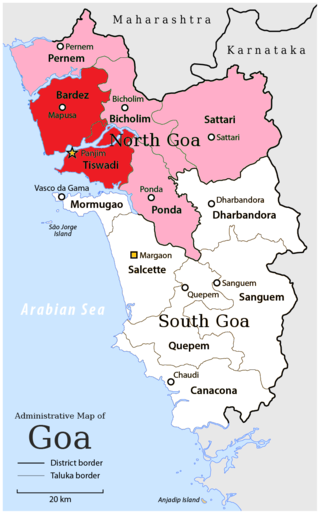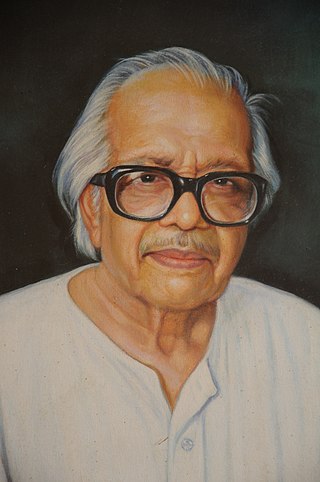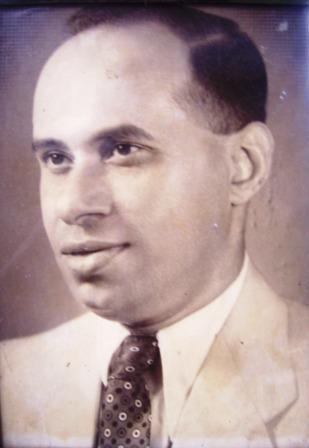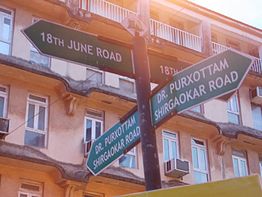
Panaji is the capital of the Indian state of Goa and the headquarters of North Goa district. Previously, it was the territorial capital of the former Portuguese India. It lies on the banks of the Mandovi river estuary in the Tiswadi sub-district (taluka). With a population of 114,759 in the metropolitan area, Panaji is Goa's largest urban agglomeration, ahead of Margao and Mormugao.

Margao is the commercial capital of the Indian state of Goa. It stands on the banks of the Sal river and is the administrative headquarters of Salcete sub-district and South Goa district. It is Goa's second largest city by population after Vasco.

North Goa district is one of the two districts that constitutes the state of Goa, India. The district has an area of 1,736 square kilometres, and is bounded by Kolhapur and Sindhudurg districts of Maharashtra state to the north and by Belgavi district of Karnataka to the east, by South Goa district to the south, and by the Arabian Sea to the west.

Mapusa is a town in North Goa, India. It is situated 13 km north of the capital Panaji. The town is the headquarters of Bardez Taluka. It is located on the main highway NH-17, linking Mumbai to Kochi.

Ram Manohar Lohia was an activist in the Indian independence movement and a socialist political leader. During the last phase of British rule in India, he worked with the Congress Radio which was broadcast secretly from various places in Bombay until 1942.

Shri Manguesh temple is located at Mangeshi Village in Priol, Ponda taluk, Goa. It is at a distance of 1 km from Mardol close to Nagueshi, 21 km from Panaji the capital of Goa, and 26 km from Margao.

Fort Aguada is a well-preserved seventeenth-century Portuguese fort, along with a lighthouse, standing in Goa, India, on Sinquerim Beach, overlooking the Arabian Sea. It is an ASI protected Monument of National Importance in Goa.

Mormugao is a seaport city situated in the eponymous Mormugao taluka (municipality) of the South district, in the Goa state, India. It has a deep natural harbour and remains Goa's chief port.

Chinchinim is a census town in Goa state, India. It is located in the Salcete taluka of South Goa district. Prior to achieving the current status of a small town, it was considered one of the biggest villages of southern Goa.

P. V. Kurian (1921–1993) was an Indian revolutionary and social activist under the British Raj.
Dr. Ram Manohar Lohia Hospital is a Central government hospital in New Delhi, India. Atal Bihari Vajpayee Institute of Medical Sciences is attached to this hospital which offers undergraduate and postgraduate courses.

Chapora Fort, located in Bardez, Goa, rises high above the Chapora River. The site is the location of a fort built by Adil Shahi dynasty ruler Adil Shah and called Shahpoora, whose name was altered to Shapora (chapora) by Malvankar on the request of the Portuguese. It is now become a popular tourist spot and offers a view north across the Chapora river to Morjim

The Annexation of Goa was the process in which the Republic of India annexed the State of India, the then Portuguese Indian territories of Goa, Daman and Diu, starting with the armed action carried out by the Indian Armed Forces in December 1961. In India, this action is referred to as the "Liberation of Goa". In Portugal, it is referred to as the "Invasion of Goa". Jawaharlal Nehru had hoped that the popular movement in Goa and the pressure of world public opinion would force the Portuguese Goan authorities to grant it independence, but without success; consequently, Krishna Menon suggested taking Goa by force.

Tristão de Bragança Cunha, alternatively spelled as Tristao de Braganza Cunha, popularly known as T B Cunha was a prominent Goan nationalist and anti-colonial activist from Goa. He is popularly known as the "Father of Goan nationalism", and was the organiser of the first movement to end Portuguese rule in Goa.

Ravindra Kelekar was a noted Indian author who wrote primarily in the Konkani language, though he also wrote in Marathi and Hindi. A Gandhian activist, freedom fighter and a pioneer in the modern Konkani movement, he was a well known Konkani scholar, linguist, and creative thinker. Kelekar was a participant in the Indian freedom movement, Goa's liberation movement, and later the campaign against the merger of the newly formed Goa with Maharashtra. He played a key role in the founding of the Konkani Bhasha Mandal, which lead the literary campaign for the recognition of Konkani as a full-fledged language, and its reinstatement as the state language of Goa. He authored nearly 100 books in the Konkani language, including Amchi Bhas Konkaneech, Shalent Konkani Kityak, Bahu-bhashik Bharatant Bhashenche Samajshastra and Himalayant, and also edited Jaag magazine for more than two decades.
Purushottam Kesava Kakodkar was a prominent politician and social worker from Goa. He served as a Member of Parliament in both the Lok Sabha and Rajya Sabha.
The Goa liberation movement was a movement which fought to end Portuguese colonial rule in Goa, Portuguese India. The movement built on the small scale revolts and uprisings of the 19th century, and grew powerful during the period 1940–1961. The movement was conducted both inside and outside Goa, and was characterised by a range of tactics including nonviolent demonstrations, revolutionary methods and diplomatic efforts. However, Portuguese control of its Indian colonies ended only when India invaded and annexed Goa in 1961, causing a mixture of worldwide acclaim and condemnation, and incorporated the territories into India.

Azad Maidan is a martyrs' monument and ground in the Indian state of Panaji, Goa. It is located opposite the Goa Police headquarters on the Mahatma Gandhi Road, Panaji. It is located at 15°30′0″N73°49′34″E.

Mohan Chandra Pant (1956–2015) was an Indian radiation oncologist, institution builder and the founder vice chancellor of the H. N. B. Uttarakhand Medical Education University, Dehradun. He served as the Director of Dr. Ram Manohar Lohia Institute of Medical Sciences, Lucknow, and was the Dean and head of the Radiotherapy Department at the King George's Medical University at the time of his death. He received the Dr. B. C. Roy Award, the highest Indian award in the medical category, from the Medical Council of India in 2005. The Government of India awarded him the fourth highest civilian honour of the Padma Shri, in 2008, for his contributions to medicine.

Julião Menezes, also known as Dr. Juliao Menezes, was an Indian freedom fighter, medical practitioner, author, and nationalist leader. He played a prominent role in the liberation of Goa from Portuguese rule and was active in the Goa liberation movement.

















